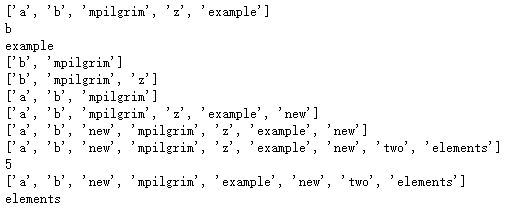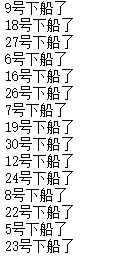str = "www.runoob.com"
print(str.upper()) # 把所有字符中的小写字母转换成大写字母
print(str.lower()) # 把所有字符中的大写字母转换成小写字母
print(str.capitalize()) # 把第一个字母转化为大写字母,其余小写
print(str.title()) # 把每个单词的第一个字母转化为大写,其余小写

import calendar
monthRange = calendar.monthrange(2016,9)
print(monthRange)

# 引入 datetime 模块
import datetime
def getYesterday():
today=datetime.date.today()
oneday=datetime.timedelta(days=1)
yesterday=today-oneday
return yesterday
# 输出
print(getYesterday())

li = ["a", "b", "mpilgrim", "z", "example"]
print(li)
print(li[1])
print(li[-1])
print(li[1:3])
print(li[1:-1])
print(li[0:3])
li.append("new")
print(li)
li.insert(2, "new")
print(li)
li.extend(["two", "elements"])
print(li)
print(li.index("example"))
li.remove("z")
print(li)
print(li.pop())

li = ['a', 'b', 'mpilgrim']
print(li)
li = li + ['example', 'new']
print(li)
li += ['two']
print(li)
li = [1, 2] * 3
print(li)

params = {"server":"mpilgrim", "database":"master", "uid":"sa", "pwd":"secret"}
print(params)
aa = ["%s=%s" % (k, v) for k, v in params.items()]
print(aa)
bb = ";".join(["%s=%s" % (k, v) for k, v in params.items()])
print(bb)
li = ['server=mpilgrim', 'uid=sa', 'database=master', 'pwd=secret']
print(li)
s = ";".join(li)
print(s)
print(s.split(";"))
print(s.split(";", 1))

li = [1, 9, 8, 4]
print(li)
aa = [elem*2 for elem in li]
print(aa)
params = {"server":"mpilgrim", "database":"master", "uid":"sa", "pwd":"secret"}
print(params.keys())
print(params.values())
print(params.items())
bb = [k for k, v in params.items()]
print(bb)
cc = [v for k, v in params.items()]
print(cc)
dd = ["%s=%s" % (k, v) for k, v in params.items()]
print(dd)
li = ["a", "mpilgrim", "foo", "b", "c", "b", "d", "d"]
print(li)
ee = [elem for elem in li if len(elem) > 1]
print(ee)
ff = [elem for elem in li if elem != "b"]
print(ff)
gg = [elem for elem in li if li.count(elem) == 1]
print(gg)

people={}
for x in range(1,31):
people[x]=1
# print(people)
check=0
i=1
j=0
while i<=31:
if i == 31:
i=1
elif j == 15:
break
else:
if people[i] == 0:
i+=1
continue
else:
check+=1
if check == 9:
people[i]=0
check = 0
print("{}号下船了".format(i))
j+=1
else:
i+=1
continue

import time
print('按下回车开始计时,按下 Ctrl + C 停止计时。')
while True:
try:
input() # 如果是 python 2.x 版本请使用 raw_input()
starttime = time.time()
print('开始')
while True:
print('计时: ', round(time.time() - starttime, 0), '秒', end="
")
time.sleep(1)
except KeyboardInterrupt:
print('结束')
endtime = time.time()
print('总共的时间为:', round(endtime - starttime, 2),'secs')
break

def sumOfSeries(n):
sum = 0
for i in range(1, n+1):
sum +=i*i*i
return sum
# 调用函数
n = 5
print(sumOfSeries(n))

# 定义函数,arr 为数组,n 为数组长度,可作为备用参数,这里没有用到
def _sum(arr,n):
# 使用内置的 sum 函数计算
return(sum(arr))
# 调用函数
arr=[]
# 数组元素
arr = [12, 3, 4, 15]
# 计算数组元素的长度
n = len(arr)
ans = _sum(arr,n)
# 输出结果
print ('数组元素之和为',ans)

def leftRotate(arr, d, n):
for i in range(d):
leftRotatebyOne(arr, n)
def leftRotatebyOne(arr, n):
temp = arr[0]
for i in range(n-1):
arr[i] = arr[i+1]
arr[n-1] = temp
def printArray(arr,size):
for i in range(size):
print ("%d"% arr[i],end=" ")
arr = [1, 2, 3, 4, 5, 6, 7]
leftRotate(arr, 2, 7)
printArray(arr, 7)

def swapList(newList):
size = len(newList)
temp = newList[0]
newList[0] = newList[size - 1]
newList[size - 1] = temp
return newList
newList = [1, 2, 3]
print(swapList(newList))

def swapPositions(list, pos1, pos2):
list[pos1], list[pos2] = list[pos2], list[pos1]
return list
List = [23, 65, 19, 90]
pos1, pos2 = 1, 3
print(swapPositions(List, pos1-1, pos2-1))

def Reverse(lst):
return [ele for ele in reversed(lst)]
lst = [10, 11, 12, 13, 14, 15]
print(Reverse(lst))

def Reverse(lst):
lst.reverse()
return lst
lst = [10, 11, 12, 13, 14, 15]
print(Reverse(lst))

test_list = [ 1, 6, 3, 5, 3, 4 ]
print("查看 4 是否在列表中 ( 使用循环 ) : ")
for i in test_list:
if(i == 4) :
print ("存在")
print("查看 4 是否在列表中 ( 使用 in 关键字 ) : ")
if (4 in test_list):
print ("存在")

from bisect import bisect_left
# 初始化列表
test_list_set = [ 1, 6, 3, 5, 3, 4 ]
test_list_bisect = [ 1, 6, 3, 5, 3, 4 ]
print("查看 4 是否在列表中 ( 使用 set() + in) : ")
test_list_set = set(test_list_set)
if 4 in test_list_set :
print ("存在")
print("查看 4 是否在列表中 ( 使用 sort() + bisect_left() ) : ")
test_list_bisect.sort()
if bisect_left(test_list_bisect, 4):
print ("存在")

RUNOOB = [6, 0, 4, 1]
print('清空前:', RUNOOB)
RUNOOB.clear()
print('清空后:', RUNOOB)

def clone_runoob(li1):
li_copy = li1[:]
return li_copy
li1 = [4, 8, 2, 10, 15, 18]
li2 = clone_runoob(li1)
print("原始列表:", li1)
print("复制后列表:", li2)

def clone_runoob(li1):
li_copy = []
li_copy.extend(li1)
return li_copy
li1 = [4, 8, 2, 10, 15, 18]
li2 = clone_runoob(li1)
print("原始列表:", li1)
print("复制后列表:", li2)

def countX(lst, x):
count = 0
for ele in lst:
if (ele == x):
count = count + 1
return count
lst = [8, 6, 8, 10, 8, 20, 10, 8, 8]
x = 8
print(countX(lst, x))

def countX(lst, x):
return lst.count(x)
lst = [8, 6, 8, 10, 8, 20, 10, 8, 8]
x = 8
print(countX(lst, x))

total = 0
list1 = [11, 5, 17, 18, 23]
for ele in range(0, len(list1)):
total = total + list1[ele]
print("列表元素之和为: ", total)

total = 0
ele = 0
list1 = [11, 5, 17, 18, 23]
while(ele < len(list1)):
total = total + list1[ele]
ele += 1
print("列表元素之和为: ", total)

list1 = [11, 5, 17, 18, 23]
def sumOfList(list, size):
if (size == 0):
return 0
else:
return list[size - 1] + sumOfList(list, size - 1)
total = sumOfList(list1, len(list1))
print("列表元素之和为: ", total)

def multiplyList(myList) :
result = 1
for x in myList:
result = result * x
return result
list1 = [1, 2, 3]
list2 = [3, 2, 4]
print(multiplyList(list1))
print(multiplyList(list2))



























